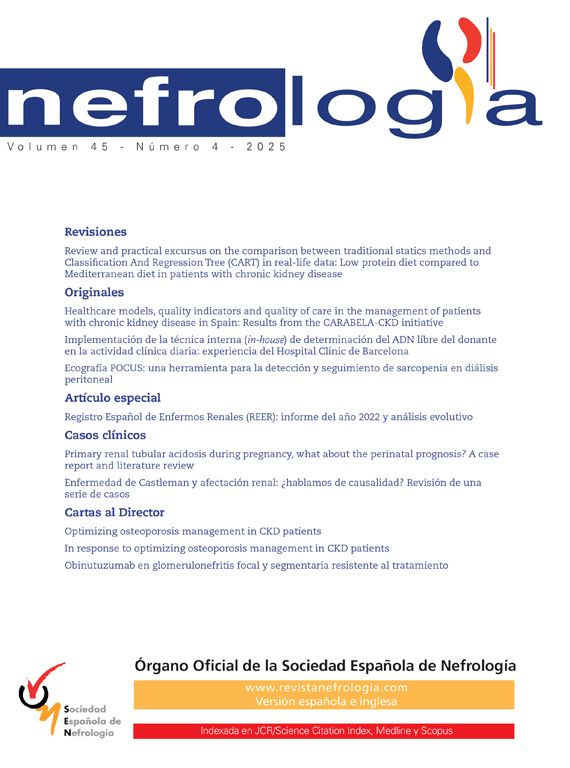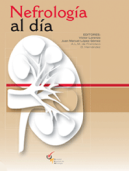Urinary diversion after cystectomy using autologous intestinal segments has been the gold standard treatment in several urinary tract diseases. The most frequent metabolic consequence is hyperchloremic metabolic acidosis, due to ammonium hydrogen and chloride ions absorption in exchange for the excretion of bicarbonate and sodium ions in the bowel conduit.
Sodium-glucose co-transporter-2 (SGLT2) inhibitors are a class of antihyperglycemic agents that block the reabsorption of filtered glucose in the renal proximal convoluted tubules, promoting greater urinary glucose and sodium excretion.
The authors describe two cases of patients with bowel conduit and mild/severe hyperchloremic metabolic acidosis, after starting SGLT2 inhibitors. Both were presented with mild acute kidney injury, moderate hyperglycemia, normal ketoacids, normal lactate and normal anion gap. Clinical and laboratory normalization were reached after this drug was withdrawn and fluid support therapy was applied.
We hypothesize that SGLT2 inhibitors could exacerbate chronic hyperchloremic metabolic acidosis in these patients, by enhance sodium loss and volume depletion, subsequent acute kidney injury (AKI), increase renal chloride elimination due to sodium loss and subsequent chloride/bicarbonate bowel exchange. Rebound hyperglycemia due to bowel absorption and bicarbonate renal elimination through Na+−H+exchanger 3 (NHE3) suppression, could also contribute. This association needs further investigation.
La derivación urinaria tras una cistectomía utilizando segmentos intestinales autólogos ha sido el tratamiento de referencia en diversas enfermedades del tracto urinario. La consecuencia metabólica más frecuente es la acidosis metabólica hiperclorémica, que resulta de la absorción de iones amonio, hidrógeno y cloruro a cambio de la excreción de iones bicarbonato y sodio en el conducto intestinal.
Los inhibidores del cotransportador sodio-glucosa 2 (SGLT2) son una clase de agentes antihiperglucemiantes que bloquean la reabsorción de glucosa filtrada en los túbulos renales proximales contorneados, lo que favorece un aumento de la glucosa urinaria.
Los autores describen dos casos de pacientes con derivación intestinal y acidosis metabólica hiperclorémica (leve a grave) tras iniciar tratamiento con inhibidores de SGLT2. Ambos pacientes presentaban lesión renal aguda leve, hiperglucemia moderada, cetoácidos normales, lactato normal y brecha aniónica normal. La normalización clínica y de los parámetros de laboratorio se logró tras la interrupción de este fármaco y la administración de terapia de soporte con fluidos.
Nuestra hipótesis es que los inhibidores de SGLT2 podrían exacerbar la acidosis metabólica hiperclorémica crónica en estos pacientes, al aumentar la pérdida de sodio y la depleción de volumen, lo que podría provocar lesión renal aguda (LRA) secundaria. Esto, a su vez, favorecería el aumento de la eliminación renal de cloruro debido a la pérdida de sodio y el posterior intercambio intestinal de cloruro/bicarbonato.
Asimismo, podría contribuir la hiperglucemia de rebote debido a la absorción intestinal de glucosa y la eliminación renal de bicarbonato a través de la inhibición del intercambiador Na+-H+3 (NHE3). Es necesario continuar investigando esta asociación.
Urinary diversion after cystectomy has been the gold standard treatment of benign and malignant urinary tract diseases, with the goal of both preserving kidney function and patient survival. Overtime, surgical procedures have been evolving and refining, with reconstruction from autologous intestinal segments taking a major role in preventing postoperative complications and favoring quality of life. The metabolic urinary abnormalities emerge due to the incorporation of a segment of bowel that is not physiologically intended to endure the composition of urine. The most frequent acid–base disorder related to ileal and colonic segments is hyperchloremic metabolic acidosis (with an incidence around 25%), apparently due to ammonium absorption along side chloride gain and bicarbonate excretion in the bowel conduit. These mechanisms could help explain the chronic acid load in these patients, but further studies are required to understand the exact underlying mechanisms.1
Sodium-glucose co-transporter-2 (SGLT2) inhibitors are antihyperglycemic agents that recently revolutionized the paradigm of chronic kidney disease: based on trials like CREDENCE, DAPA-CKD and EMPA-KIDNEY, they reduce the risk of kidney disease progression or death from cardiovascular causes in a broad range of patients, including non-diabetics. This class exerts its effect by preventing the reabsorption of filtered glucose from the tubular lumen, acting directly on the SGLT2 proteins in the renal proximal convoluted tubules and promoting a greater urinary sodium and glucose excretion. Recent evidence from animal models account for a functional interaction and indirect suppression of Na+−H+exchanger 3 (NHE3), enhancing natriuresis and bicarbonate elimination; to reach acid–base balance and in response to chronic use of SGLT2 inhibitors (urinary glucose and sodium loss), there are some compensatory responses to acidification of proximal tubular cells and reach, through the expression of renal genes, related to renal gluconeogenesis, bicarbonate regeneration and ammonium formation (increase urinary α-ketoglutarate to minimize bicarbonaturia under alkali load).2,3
On the other hand, the SGLT1 proteins account for most of the dietary glucose uptake in the intestine and the remainder of the filtered renal glucose (located in the late proximal tubule).
In medical literature so far, there are no cases described of severe hyperchloremic metabolic acidosis after starting SGLT2 inhibitors in patients with a bowel conduit.
Case reportCase 1: A 62-year-old male with an orthotopic neobladder since 2005 (after the diagnosis of bladder malignancy), type 2 diabetes and nonspecific interstitial pneumonia. In 2018 his arterial blood gas (ABG) was compatible with a mixed disturbance of a light hyperchloremic metabolic acidosis and a respiratory alkalosis, a light hypokalemia: pH 7.45, pO2 81mmHg, pCO2 28mmHg, HCO3− 19.3mmol/L, Cl− 107mmol/L, K+ 3.25mmol/L, anion gap (AG) 7.7mmol/L (normal albumin). In February 2022 he was sent to the emergency department from pneumology outpatient clinic, after his ABG showed a hyperchloremic metabolic acidosis: pH 7.25, pCO2 27.5mmHg, pO2 75mmHg, HCO3− 12mmol/L, Cl+ 122mmol/L, Na+ 143mmol/L, K+ 3.74mmol/L, AG 9mmol/L (normal albumin), lactate 0.69mmol/L, glucose 261mg/dL, normal ketone bodies. At presentation the observation was remarkable and blood workup showed acute kidney injury (AKI), with urea 81mg/dL and creatinine 1.6mg/dL. The patient medical history revealed: administration of five cycles of cyclophosphamide (seven months before the hospitalization), suspended after an emerging left arm peripheral neuropathy, without laboratory abnormalities; and the introduction of empagliflozin 10mg id and metformin 1000mg id, 10 months prior to this event. The patient reported aggravated polyuria and moderate hyperglycemia since the therapeutical change. A progressive metabolic and renal function normalization was observed after the SGLT2 inhibitor was withdrawn and intravenous hydration with polyelectrolyte was started. One year later, this patient presented to the emergency department with nausea and lethargy undergoing for four weeks; similarly, he had normal vital signs, remarkable observation and workup compatible with hyperchloremic metabolic acidosis (pH 7.15, pCO2 34.3mmHg, pO2 96.2mmHg, HCO3− 11.7mmol/L, Cl+ 115mmol/L, Na+ 138.1mmol/L, K+ 3.64mmol/L, AG 11mmol/L, normal albumin, lactate 0.69mmol/L, glucose 330mg/dL), normal ketone bodies and AKI (urea 110mg/dL, creatinine 1.77mg/dL). He had started dapagliflozin 10mg, three months before the described symptoms, again also with persistent hyperglycemia and polyuria. Once fluid therapy and sodium bicarbonate were given, as well as SGLT2 inhibitor was suspended, the patient's clinical and metabolic status returned progressively to baseline.
Case 2: A 63-year-old male with an ileal conduit since 2018 (after bladder cancer diagnosis), type 2 diabetes and chronic renal disease since 2021 (with serum creatinine 1.5–2mg/dL), presented with a three-day history of lethargy and anorexia. He had started dapagliflozin 10mg daily, 10 months prior to this event. At admission the patient had normal vital signs and no major signs at observation, with laboratory evaluation revealing: severe hyperchloremic metabolic acidosis (ABG: pH 6.98, pCO2 20.5mmHg, pO2 124.4mmHg, HCO3− 4.7mmol/L, Na+ 129mmol/L, Cl− 120mmol/L, AG 4.3mmol/L, K+ 3.54mmol/L, glucose 200mg/dL, lactate 0.5mmol/L); AKI (urea 209mg/dL and creatinine 2.8mg/dL); and spot urine without ketone bodies. Head and abdominopelvic computed tomography showed no acute complications and there were no signs or symptoms of concomitant infection. He was admitted for a short period to the intensive care unit, for intravenous sodium bicarbonate and hydration with polyelectrolyte, on top of SGLT2 inhibitor suspension, with progressive clinical and metabolic resolution. The patient later stated that since the introduction of the SGLT2 inhibitor, his peripheral glucose levels were consistently high.
DiscussionChronic hyperchloremic metabolic acidosis is a frequent complication of urinary diversion, due to the reabsorption of urinary solutes by the intestinal mucosa (ammonium and chloride absorption and bicarbonate excretion), as well as diarrhea and volume depletion, consequences of reduced sodium absorption in the gout. Euglycemic ketoacidosis is a well-known complication of SGLT2 inhibitor therapy that was excluded in these cases, as both patients had normal anion gap. Metformin-associated lactic acidosis was also ruled out, as lactate values were persistently normal. Although both patients had AKI, we consider it was not severe enough to cause this grade of hyperchloremic acidemia, that has been previously described but with milder gravity. Also, both patients reached clinical and laboratory normalization shortly after SGLT2 inhibitor withdrawn and support therapy. Apart from that, these patients experienced overt and persistent hyperglycemia and aggravating related symptoms (like polyuria) since the beginning of therapy with SGLT2 inhibitors, which accounts for possible metabolic impairments since then.
Furthermore, when one of these patients started taking a SGLT2 inhibitor once more, a relapse occurred.
We hypothesize that SGLT2 inhibitors could exacerbate chronic hyperchloremic metabolic acidosis in these patients, by enhance sodium loss and volume depletion and subsequent AKI, increase renal chloride elimination due to sodium loss to maintain the tubule electroneutrality and subsequent chloride bowel absorption and bicarbonate bowel loss. The bicarbonate renal elimination through NHE3 suppression as well as rebound hyperglycemia due to previously excreted urinary glucose reabsorption in the intestinal segment are other possible explanations. This reabsorption could be through the non-inhibited intestinal graft SGLT1 proteins. After an extensive literature survey, the authors did not find any case reports or series about this topic. We believe these are the first two cases reported of severe hyperchloremic metabolic acidemia in patients with urinary diversion exacerbated by SGLT2 inhibitors. Despite the possible involvement of SGLT1 receptors, the pathophysiology of this presentation still needs further investigation, as well as the security to use these highly selective SGLT2 inhibitors in this population.
CRediT authorship contribution statementAll authors contributed equally to literature search, writing, review, and approval of the manuscript. All authors have read and agreed to the published version of the manuscript.
FundingNo funding was received for this manuscript.






